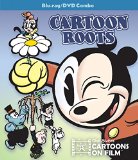| Reviews & Columns |
|
Reviews DVD TV on DVD Blu-ray 4K UHD International DVDs In Theaters Reviews by Studio Video Games Features Collector Series DVDs Easter Egg Database Interviews DVD Talk Radio Feature Articles Columns Anime Talk DVD Savant Horror DVDs The M.O.D. Squad Art House HD Talk Silent DVD
|
DVD Talk Forum |
|
|
| Resources |
|
DVD Price Search Customer Service #'s RCE Info Links |
|
Columns
|
|
|
Cartoon Roots
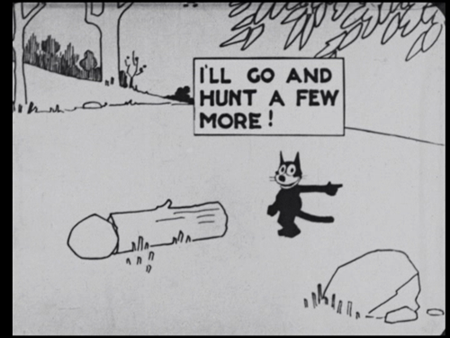
Please Note: The stills used here are taken from the DVD portion of Cartoon Roots.
The Cartoons:
Far from being a tossed-off, randomly thrown-together set of public domain cartoons, Cartoon Roots presents an expertly curated program of shorts from animation's early, developmental years.
Although my description makes Cartoon Roots sound dry as toast, this disc contains some funky, strange stuff (those who fondly remember the "King of Cartoons" segments from Pee-Wee's Playhouse will relate). Before Walt Disney introduced Mickey Mouse and set the standard (for better or worse), the animation industry was a crazy-quilt of different styles and complexities - Cartoon Roots certainly reflects that. Originally released in 1907-1932, these sixteen restored cartoons showcase an art form that was awkwardly developing - and brimming with vitality.
Cartoon Roots is the first collection released under the banner of Cartoons On Film, the outfit belonging to Queens, New York-based cartoon collector and archivist Tom Stathes (full disclosure: I'm Facebook friends with Mr. Stathes, although otherwise I'm just a fan who's never dealt directly with him). With silent-era film stock deteriorating, the efforts by people like Stathes at locating extant prints, cataloguing obscure short films and bringing them back into circulation is incredibly valuable. A set like Cartoon Roots not only offers a window on what animated entertainment was like in its infancy, it helps keep film preservation alive.
The fifteen cartoons assembled on Cartoon Roots span about 97 minutes in length and are divided into three non-chronological sections. While many of them are intact archival prints with newly scored soundtracks, some sport alternate titles or scores made for their television broadcasts in the 1950s.
Beginnings and Pioneers
- Lightning Sketches (Vitagraph/J. Stuart Blackton, 1907)
A quaint example of the earliest animation on film, when it served as an extension of vaudeville "chalk talk" acts in which an artist would demonstrate changing funny pictures with drawing instrument, board and slight-of-hand. This particular one showcases the handiwork of James Stuart Blackton in sketches similar to what he did in the better-known Humorous Phases of Funny Faces (1906). - Cartoons On Tour (Raoul Barré, 1915)
In this enjoyable cartoon/live action combo, a lovestruck woman drags her disapproving father to her wedding while animated domestic scenes are interspersed in the action. The cartoons are incorporated via the characters reading their exploits in a newspaper's funnies section. An early effort from pioneering animator Bill Nolan, who redesigned Felix the Cat and directed several cartoons for Walter Lantz (also showcased in this set). - Col. Heeza Liar, Detective (Bray/Vernon Stallings, 1923)
Although many early animated shorts relied on characters that were already popular in newspaper comic strips, the adventuresome Colonel Heeza Liar was an original creation from animator J. R. Bray. Concerning a stolen prize chicken, Detective incorporated live action segments in a humorous, sometimes unsettling way (I cannot unsee the segment where they bring the rooster back to life!). - Bobby Bumps Starts To School (Earl Hurd, 1917)
In this simple short, troublemaking Bobby Bumps causes mischief when playing hooky and ringing the bell at school. This was an early, rudimentary example of cel-based animation, the technique pioneered by Bobby Bumps creator Earl Hurd. It's astonishing to note how different these shorts looked from the crude "moving comics" format used just a few years earlier. - The Circus (Max Fleischer, 1920)
Aside from the early Mickey Mouses, Max Fleischer's delightful "Out of the Inkwell" series with Koko the Clown served as the earliest silent cartoons I ever saw. The Circus has a partially rotoscoped Koko attempting to train a stubborn show horse, with smoothly integrated patter from his live action director, Fleischer. - The Jolly Rounders (Paul Terry, 1923)
This installment of the "Aesop's Fables" series from animation pioneer Paul Terry centers on an unhappily married lady hippo and her husband, Harry - who gets taught a lesson about straying husbands by his own brother in drag as alluring lady hippo (!). Since most of the "Aesop's Fables" were geared towards children, this crudely done tale seems especially bizarre to modern eyes.
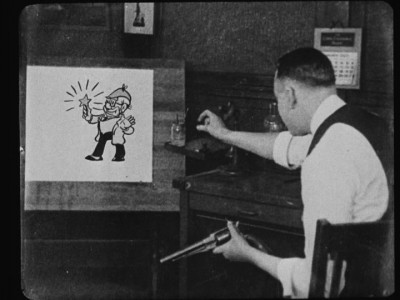
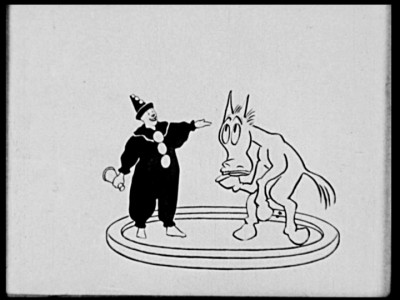
Classic Characters
- Fireman Save My Child (Fox/Dick Huemer, 1919)
Popular newspaper comic strip duo "Mutt and Jeff" take center stage in this frantic short, wherein the two are firemen battling a hotel fire with varying degrees of success. Expressive animation from the legendary Dick Huemer (Dumbo; Alice in Wonderland). - The Bomb Idea (Bray/IFS, 1920)
An entry in the now-forgotten "Jerry On The Job" cartoon series has boy railroad porter Jerry and his boss, Mr. Gibney, being spooked by a mysterious bomb-toting visitor. An early effort from Woody Woodpecker creator Walter Lantz with some memorably surreal gags. - Felix Comes Back (Pat Sullivan/Otto Messmer, 1922)
A crude, chunky-looking Felix the Cat gets frozen in a block of ice and shipped to the North Pole, where he tussles with an angry polar bear, a seal and a penguin. Felix's impish personality comes through on many of these clever gags, which are quite smoothly executed for 1922. - Springtime (Paul Terry, 1923)
Another of Terry's "Aesop's Fables" not-really-for-kiddies cartoons follows Farmer Al Falfa as he scopes out bathing beauties at the beach, where he attempts all sorts of crazy stuff (roasting himself on a rotisserie) to make himself more attractive. Another delightfully bizarre creation which makes me ponder the possibility of a Best of Aesop's Fables package. - Scents and Nonsense (Winkler/Bill Nolan, 1926)
With a loopy story involving a cat retrieving various animals for a human furrier (a Jewish stereotype) to make into skins, Scents and Nonsense counted as one of the cartoons loosely based on George Herriman's beloved Krazy Kat comic strip. Although Krazy is portrayed as a male cat and adversary Ignatz Mouse is completely missing, this remains an amusing, bizarre entry in what is apparently a rare series (according to this set's liner notes, distributor Margaret Winkler foolishly had the negatives for Krazy and a few other series destroyed to save on storage fees). - Lost and Found (Bray/Walter Lantz, 1926)
Live action and animation are elegantly woven together in this frantic short starring "Dinky Doodle," an early creation of Walter Lantz. Like Dave Fleischer on his "Koko the Clown" shorts, Lantz himself appears here as a cartoonist who helps Dinky and his canine pal, Weakheart, foil a devious kidnapper who abducted a lovely lady. Cute, and fun. For interested parties, another Dinky Doodle short is included on Thunderbean's A Conversation with Walter and Gracie Lantz DVD.
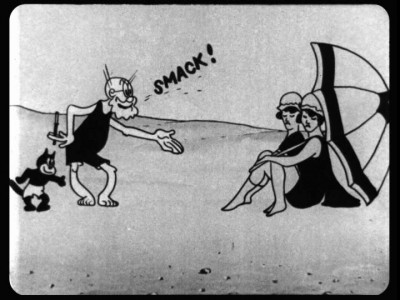
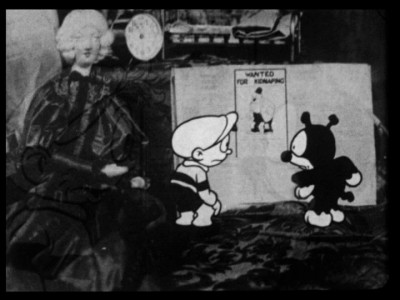
Early Sound Rarities
- Hot-Toe Mollie (Romer Grey, 1930)
This jazzy short was one of two efforts in the very brief "Binko the Bear Cub" series. Completed in 1930 yet never exhibited in theaters, Hot-Toe Mollie makes it debut on this very release - and what a treat it is. Created by a team of future animation stars including Preston Blair and brothers Bob and Tom McKimson, this fragmentary short of Binko haunting a run-down Mexican cantina whizzes along with funky, freaky visuals and fluid movement. - The Milkman (Winkler/Dick Huemer, 1930)
The Milkman was part of a short-lived series starring Toby, an endearingly grouchy dog. As Toby reluctantly goes out on his milk delivery rounds, we're treated to many clever Fleischer-like anthropomorphic gags and an outstanding, rubbery visual flair. Nearly as slick as contemporary 'toons from Mickey Mouse and Betty Boop, this romp served as a great showcase for Dick Huemer and animators Art Davis and Sid Marcus. - Farmerette (Van Bueren, 1932)
This "Aesop's Fables" entry actually ended up being my favorite in the set for the mere fact that it's a slavish (but entertaining) imitation of the Fleischer studio's early '30s style. In it, a goat farmer - upset by the lack of energy among his farmhands - hires a flirty little girl cat to help out. With a strikingly Betty Boop-ish song and dance, she turns the operation around into a hopping, jazzed-up hot spot. The frenetic visuals also reminded me of current comic artist Kim Deitch (who freely acknowledges the influence of hallucinatory cartoons like this one).
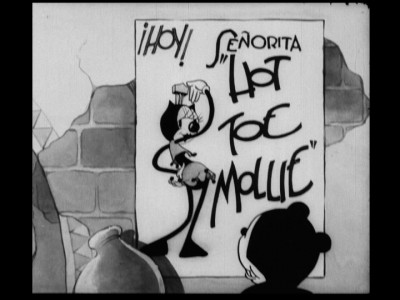
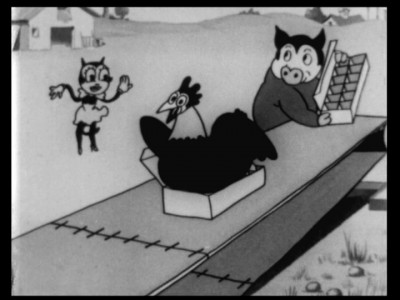
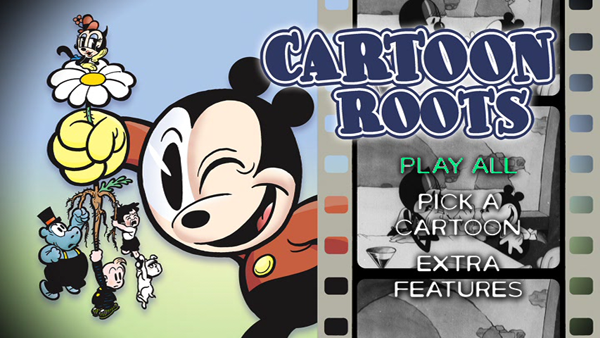
The Blu Ray:
Cartoon Roots arrives as a Blu Ray/DVD combo packaged in a standard Blu-sized keep case adorned with period-appropriate artwork by Stephen DeStefano.
Video
All of these cartoons have been given an excellent digital restoration from a team headed by Thunderbean Animation's Steve Stanchfield. While they have their share of age and damage (although the never-before-released Hot-Toe Mollie looks astonishingly pristine), the restoration keeps the integrity of the celluloid prints while cleaning up bits of scratches and dirt. Many of these cartoons come from syndicated TV prints with updated title cards (I suppose the originals are presumed lost), while most are presented as they originally were seen in theaters. Copyright notices are imprinted on the screen in the final seconds.
Audio
Many of the silent cartoons on this set have been given new, clean stereophonic scores by Robert Israel and Ben Model. Israel and Model, both vets at scoring silent features, furnish these cartoons with fully orchestrated tracks which complement the lively onscreen action. A few use sprightly music-and-effects soundtracks supplied for their television broadcasts in the '50s, which although ragged sounding capture the '20s atmosphere remarkably well. The early sound cartoons on this set sound predictably scratchy, but they're serviceable enough with no outstanding flaws.
Extras
Stathes has included a bunch of vintage publicity and other material directly relating to the cartoons, mostly as click-through image galleries. Vintage Publicity includes several contemporary reviews and trade ads; Brick Bodkins' Pa shares a vintage comic strip which was a predecessor for Bobby Bumps; while Mutt and Jeff Film Funnies presents an unusual instance of animated cartoons adapted into print; Farmer Al and Byron Harlan is audio of three novelty 78 RPM records using the Farmer Al Falfa character; a brief bit of reversed music from Hot-Toe Mollie is corrected in "Backwards" Binko; Behind The Scenes offers several "production documents, copyright synopses and other rare relics"; The Circus is presented in an alternate TV version with the intertitles replaced with narration from voice actor Allen Swift (in addition to the cartoon, the original shooting script is included, revealing that Swift ad-libbed parts of the narrative). In addition to the disc extras (which are repeated on both Blu Ray and DVD), an 8-Page Booklet supplies informative background information on each cartoon along with supplementary text from Stathes, Jerry Beck and David Gerstein. A text page of credits round out the extras.
Final Thoughts
Rubber-limbed, black and white goodness. The fifteen restored vintage animated shorts collected on Cartoon Roots trace the period when animation matured from crude drawings on paper to the wild, jazzy early sound era. Painstakingly curated by animation historian Tom Stathes, this feature-packed set spotlights early animation in all its primitive, screwy glory. Highly Recommended.
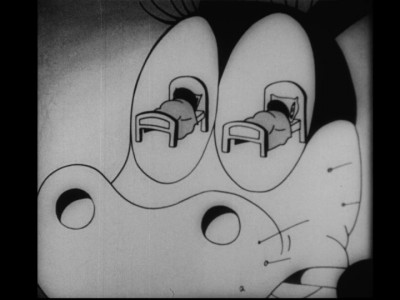
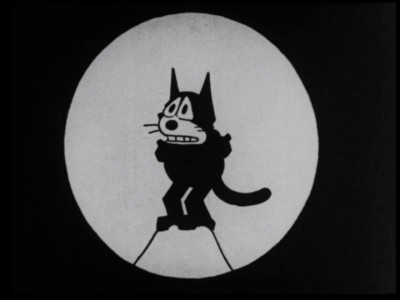
Matt Hinrichs is a designer, artist, film critic and jack-of-all-trades in Phoenix, Arizona. Since 2000, he has been blogging at Scrubbles.net. 4 Color Cowboy is his repository of Western-kitsch imagery, while other films he's experienced are logged at Letterboxd. He also welcomes friends on Twitter @4colorcowboy.
|
| Popular Reviews |
| Sponsored Links |
|
|
| Sponsored Links |
|
|
| Release List | Reviews | Shop | Newsletter | Forum | DVD Giveaways | Blu-Ray | Advertise |
|
Copyright 2024 DVDTalk.com All Rights Reserved. Legal Info, Privacy Policy, Terms of Use,
Manage Preferences,
Your Privacy Choices | |||||||









